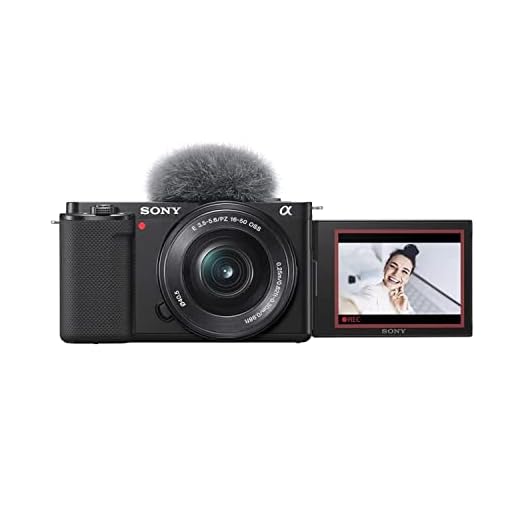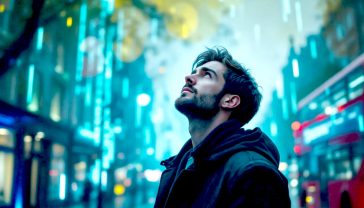Sony Alpha ZV-E10 Review: The Ultimate Guide for Britain’s Next Top Creators
Our in-depth Sony ZV-E10 review for the UK market. We explore its 4K video, autofocus, audio, and lens options for aspiring content creators.

This post may contain affiliate links. If you make a purchase through these links, we may earn a commission at no additional cost to you.
Ever watched your favourite YouTuber from their London flat or a travel vlogger exploring the Scottish Highlands and thought, “I could do that”? Well, you’re not alone. More and more people across the UK are picking up cameras to share their passions. But getting started can feel a bit daunting, especially when you see all the fancy gear out there. What if there was a camera that was simple enough for a beginner but powerful enough to make your videos look properly professional?
That’s exactly where the Sony Alpha ZV-E10 comes in. Think of it as the perfect first step into the world of serious content creation. It’s a camera built from the ground up for people who want to make brilliant videos without getting bogged down in confusing menus and technical jargon. It’s small enough to chuck in your bag for a day out in Manchester, but it packs the punch of a much bigger, more expensive camera.
In this guide, we’re going to dive deep into everything the ZV-E10 has to offer. We’ll look at what makes it so special for vloggers, from its flip-out screen to its amazing autofocus. We’ll talk about the sound, the picture quality, and which lenses you might want to buy to take your videos to the next level. Whether you’re planning to start a beauty channel from your bedroom in Birmingham or document your hiking adventures in the Brecon Beacons, we’ll help you decide if the Sony ZV-E10 is the right camera to bring your ideas to life.
What Exactly is the Sony ZV-E10?
So, what is this camera everyone’s talking about? At its heart, the Sony ZV-E10 is a mirrorless camera with interchangeable lenses. Let’s break that down.

Sony Alpha ZV-E10L | APS-C Mirrorless interchangable-lens vlog camera with 16-50mm lens

SONY Alpha ZV-E10 – APS-C Interchangeable Lens Mirrorless Vlog Camera – Black

Sony ZV-E10M2 Mirrorless Vlogging Camera wtih 16-50mm Lens (26MP APS-C Sensor, 4K 60p Video, Flip Screen, Real-Time Eye AF, USB-C Streaming – Ideal for…
- Mirrorless: Older cameras, called DSLRs, used a mirror inside to show you what the lens was seeing. Mirrorless cameras, like the ZV-E10, don't have that mirror. This makes them smaller, lighter, and often faster. What you see on the screen is exactly what your video will look like.
- Interchangeable Lenses: This is the really exciting bit. Unlike your phone or a simple point-and-shoot camera, you can change the lens on the ZV-E10. Want a blurry, cinematic background for your sit-down chats? Pop on a "prime" lens. Want to capture a wide shot of the stunning Cornish coastline? Use a "wide-angle" lens. This flexibility is what separates beginner gear from the stuff the pros use. It means the camera can grow with you as your skills improve.
Sony designed the ZV-E10 specifically for vloggers and content creators. They took the best bits from their other popular cameras, like the fantastic image quality and autofocus, and added features that make a vlogger's life easier. It’s the successor to the much-loved ZV-1, but with the massive advantage of being able to change lenses.
Who is This Camera For?
The ZV-E10 hits a sweet spot. It's perfect for:
- Aspiring YouTubers: If you're ready to step up from your smartphone, this camera will give your videos a huge leap in quality.
- Vloggers and Influencers: Its small size and flip-out screen make it ideal for filming yourself on the go.
- Streamers: With a simple USB connection, it can be used as a high-quality webcam for Twitch or YouTube streaming.
- Small Businesses: If you need to create professional-looking product videos or social media content, the ZV-E10 is a powerful and affordable tool.
It’s not really for people who only want to take photos. While it can take very good pictures, it’s missing a viewfinder (the little window you look through on other cameras), and its controls are all designed around making video as easy as possible. It's a video-first camera, through and through.
Unboxing and First Impressions: What's in the Box?
Opening a new piece of kit is always exciting. When you get your hands on the ZV-E10, the first thing you'll notice is how light it feels. It’s mostly made of high-quality plastic, which helps keep the weight down – something you’ll be thankful for when you’re holding it at arm's length to film yourself.
Inside the box, you’ll typically find:
- The Sony ZV-E10 camera body.
- The 16-50mm "kit" lens (if you buy it as a bundle).
- A rechargeable battery (the NP-FW50).
- A USB-C cable for charging and connecting to a computer.
- A power adapter.
- A strap to hang it around your neck.
- A "dead cat" windscreen for the microphone.
That last one sounds a bit grim, but it’s a fluffy cover that slips over the camera’s built-in microphone. It's brilliant at cutting out wind noise when you're filming outside, which is a massive bonus for anyone vlogging in famously breezy Britain. It’s a small touch, but it shows Sony was really thinking about vloggers.
Design and Handling
The camera has a simple, clean design. On the front, there’s a decent-sized grip that makes it comfortable to hold. On the top, you’ll find the most important buttons. There's a big red button for starting and stopping recording – you can't miss it. There's also a button labelled "Background Defocus" (we'll talk more about that amazing feature later) and a mode button to switch between video, photo, and a special Slow & Quick mode.
The most important feature for any vlogger is the screen. The ZV-E10 has a fully articulating, vari-angle touchscreen. This means it flips out to the side and can be tilted up, down, and all the way around to face you. You can see yourself perfectly while you're filming, making sure you're in shot and in focus. It's a total game-changer compared to filming blind on a phone or a camera with a fixed screen.
On the side, you’ll find all the ports you need: a microphone input (essential for good audio), a headphone jack (so you can listen to your audio while recording), a micro HDMI port, and a USB-C port. Having the microphone port is a huge plus, as it means you can easily upgrade your sound with an external mic.
The Heart of the Camera: Image Quality and Sensor
Now for the technical bit, but don't worry, we'll keep it simple. The quality of your videos comes down to two things: the sensor and the lens. The sensor is the part inside the camera that actually captures the light, like the film in an old camera.
The ZV-E10 has a 24.2-megapixel APS-C sensor. That might sound like a load of gobbledygook, but what it means is that the sensor is big. It's the same size as the sensors found in much more expensive, professional cameras. It’s much, much bigger than the tiny sensor in your smartphone.
Why Does a Big Sensor Matter?
A bigger sensor can capture more light. This has two huge benefits:
- Better Low-Light Performance: Ever tried filming on your phone in a dimly lit pub or at home in the evening? The video often looks grainy and noisy. The ZV-E10's large sensor means it performs brilliantly in low light. You can film clean, crisp video without needing massive, bright studio lights. This is perfect for creating a cosy, natural look in your videos.
- Shallow Depth of Field (Blurry Backgrounds): This is the secret to that "cinematic" look everyone wants. A large sensor makes it much easier to get a blurry background, making the subject (you!) stand out. The ZV-E10 makes this even simpler with its special "Background Defocus" button.
Video Specs: 4K and Frame Rates
The ZV-E10 can shoot beautiful 4K video. This gives you incredibly detailed, sharp footage that looks amazing on modern TVs and computer screens. It actually records in an even higher resolution (6K) and then shrinks it down to 4K. This process, called "oversampling," packs in even more detail and results in a cleaner image.
You can also choose different frame rates. For a standard, natural look, you'll shoot in 25fps (frames per second), which is the standard for UK television. But you can also shoot in 50fps or 100fps in Full HD (1080p). This allows you to slow your footage down to create beautiful, smooth slow-motion clips. Imagine capturing the steam rising from a cup of tea or a dog jumping for a ball in graceful slow-mo – it’s a great way to make your videos more dynamic and professional.
The Magic Button: Background Defocus and Product Showcase
Sony knew that many people buying the ZV-E10 might not want to learn about complicated settings like "aperture." They just want that lovely blurry background. So, they added a dedicated button on top of the camera: C1 / Background Defocus.
Press it once, and the camera will instantly open up the lens to its widest setting, blurring out the background. Press it again, and the background will become sharp and clear.
- Simplified Explanation: Think of it like a magic switch for making your background either blurry or sharp.
- Detailed Explanation: Technically, this button toggles the lens's aperture between its widest setting (e.g., f/3.5 on the kit lens) and a smaller setting (e.g., f/8). A wider aperture lets in more light and creates a shallower depth of field, which is what causes the background blur. It’s a brilliant shortcut that saves you from diving into the menus.
Product Showcase Mode
This is another genius feature for a specific type of creator. If you review products – whether it's makeup, gadgets, or books – you'll love this.
Normally, a camera’s autofocus will always try to focus on a person's face. If you hold a product up to show the camera, the focus might stay locked on you, leaving the product blurry.
With Product Showcase Mode turned on, the camera's priorities change. As soon as you hold an object up in front of your face, the focus will snap instantly to that object. When you move it away, the focus smoothly returns to your face. It works incredibly well and makes filming product reviews effortless. It’s perfect for beauty gurus showing off a new lipstick or a tech reviewer demonstrating a new phone.
Autofocus That Never Lets You Go
If there's one thing Sony cameras are famous for, it's their autofocus. And the ZV-E10 has one of the best systems around. It's fast, reliable, and incredibly "sticky."
The camera uses Real-time Eye AF and Real-time Tracking. This means it can find a person's eye in the frame and lock focus on it. Even if you move around, turn your head, or walk towards and away from the camera, the focus stays glued to your eye.
This is a massive deal for solo creators. You can set the camera up on a tripod, press record, and be completely confident that you will be perfectly sharp throughout your entire video. You don't need a friend to check focus for you. You can just relax and concentrate on what you're saying.
The autofocus works just as well on objects. You can tap on the screen to select what you want to focus on, and the camera will track it as it moves around the frame. It's so good that you can pretty much set it to its widest focus area, forget about it, and let it do its thing. It just works.
Sounding Superb: The Built-in Microphone and Audio Options
They say that audio is half of the video. You can have the most beautiful 4K footage, but if your sound is tinny, echoey, or full of wind noise, people will click away.
Sony has put a lot of effort into the ZV-E10's audio. It has a large, three-capsule directional microphone built right into the top of the camera. This is a big step up from the tiny pinhole mics on most cameras. It's designed to pick up sound clearly from in front of the camera (where you are) while reducing noise from the sides and back.
And remember that fluffy windscreen that comes in the box? It makes a huge difference when filming outdoors. On a blustery day at Brighton beach, it can be the difference between usable audio and a rumbling mess.
Taking Your Audio to the Next Level
While the built-in mic is good for getting started, the real power of the ZV-E10 is its expandability. It has a 3.5mm microphone input jack, which is the standard connection for most external microphones. This means you can easily plug in:
- A Shotgun Mic: These mount on top of the camera (on the "hot shoe") and give you even more directional, high-quality sound. The Rode VideoMicro or VideoMic GO II are popular choices that pair perfectly with the ZV-E10.
- A Lavalier Mic (Lapel Mic): These are the little mics you clip onto your shirt. They are fantastic for interviews or for filming in noisy places because the microphone is right next to your mouth, cutting out most background noise.
The ZV-E10 also has a headphone jack. This is a pro-level feature that lets you listen to the audio as it's being recorded. You can check for any problems, like wind noise or clothes rustling against a lavalier mic, and fix them right away, saving you a headache in the editing room.
The World of Lenses: Expanding Your Creativity
The single biggest reason to choose the ZV-E10 over a compact vlogging camera like the Sony ZV-1 or a DJI Pocket is the ability to change lenses. The camera uses Sony's E-mount, which is one of the most popular lens systems in the world. This means you have a massive selection of lenses to choose from, both from Sony and from other manufacturers like Sigma and Tamron.
The 16-50mm Kit Lens
Most people will buy the ZV-E10 with the standard 16-50mm kit lens. It's a decent little lens to get you started. It's small, light, and has a versatile zoom range. At 16mm, it's wide enough for vlogging at arm's length. Zoomed in to 50mm, it's great for tighter shots or product close-ups. It also has built-in image stabilisation (Optical SteadyShot), which helps to make your handheld footage a bit smoother.
However, the kit lens has its limitations. Its aperture is not very "fast" (meaning it doesn't let in a huge amount of light), so it's not the best for getting that super blurry background or for filming in very dark conditions. It’s a great starting point, but the real fun begins when you add another lens to your bag.
Recommended Lenses for the ZV-E10
Here are a few popular lens choices for ZV-E10 users in the UK:
- For Blurry Backgrounds (Sigma 16mm F1.4 DC DN): This is probably the most popular lens for the ZV-E10, and for good reason. It’s a wide-angle lens, perfect for vlogging, but its F1.4 aperture is incredibly "fast." This lets in a huge amount of light and creates a beautifully creamy, blurry background. It will instantly make your videos look more professional and cinematic. It's a must-have for anyone serious about their image quality.
- For Ultimate Portability (Sony E 10-18mm f/4 OSS): If you're a travel vlogger, this is a fantastic choice. It’s an ultra-wide zoom lens, meaning you can get those epic wide shots of landscapes or cityscapes, and it's also great for vlogging as it gets so much of the background in the shot. It's small, light, and has image stabilisation.
- For a Budget Upgrade (Sony E 50mm f/1.8 OSS): This is a classic "nifty fifty." It's an affordable prime lens that is brilliant for portraits and sit-down videos where you want to completely obliterate the background. The 50mm focal length gives a very flattering look for faces. It also has stabilisation, which is a nice bonus.
Stability: The Achilles' Heel?
If the ZV-E10 has one weakness, it's image stabilisation. The camera itself does not have In-Body Image Stabilisation (IBIS). This is a system where the sensor itself moves to counteract camera shake. More expensive cameras often have this, and it makes for very smooth handheld footage.
The ZV-E10 relies on two other things:
- Lens Stabilisation (Optical SteadyShot): Many Sony lenses have stabilisation built into the lens itself. This helps, but it’s generally not as effective as IBIS.
- Electronic Stabilisation (Active SteadyShot): The camera can use software to stabilise the footage. It does this by slightly cropping into the image and moving the frame around to smooth out shakes. It works pretty well, but there are two downsides. First, the crop means your shot becomes a bit tighter, which isn't ideal for vlogging. Second, it can slightly reduce the image quality.
How to Get Smooth Footage
So, what's the solution? While you can get usable handheld footage straight from the camera (especially if you use a lens with stabilisation), for the best results, you'll want to use a gimbal. A gimbal is a motorised stabiliser that keeps the camera perfectly smooth, no matter how much you move. The ZV-E10 is so small and light that it works perfectly with popular, affordable gimbals like the Zhiyun Crane M3 or the DJI RSC 2.
Alternatively, using a tripod like a Gorillapod or a simple mini-tripod for your sit-down shots will, of course, give you perfectly stable footage. For vlogging, learning to walk smoothly (the "ninja walk"!) and holding the camera with two hands can also make a big difference.
Usability and Software: The Good and The Bad
Using the ZV-E10 is mostly a joy. The buttons are well-placed, the flip-out screen is brilliant, and the simple one-touch features like Background Defocus are fantastic for beginners. There's also a tally light on the front – a red light that shows you when you're recording. It’s a small thing, but it gives you peace of mind that you actually pressed the button.
However, Sony's menu system is famously a bit confusing. While the most important features are easy to access, if you want to dive deeper into the settings, you might find yourself getting a bit lost in the endless tabs and pages. Thankfully, once you've got the camera set up the way you like it, you shouldn't need to go into the full menu very often.
The camera can also be used as a very high-quality webcam. You just plug it into your computer's USB port, and it will be recognised as a video source for apps like Zoom, OBS, or Microsoft Teams. This is a fantastic feature for streamers or anyone who wants to look their best on video calls.
Battery Life
The camera uses Sony's older NP-FW50 battery. It's not the best. You can expect to get around 60-80 minutes of continuous 4K recording from a single charge. If you're planning a long day of shooting, you will definitely need to buy a few spare batteries. The good news is that they are cheap and widely available. You can also power and charge the camera via its USB-C port, so you can run it from a portable power bank for very long recording sessions.
The Verdict: Should You Buy the Sony ZV-E10 in 2025?
So, after all that, is the Sony ZV-E10 the right camera for you?
If you are a budding content creator, vlogger, or streamer in the UK looking for your first serious camera, the answer is a resounding yes. For its price, the Sony ZV-E10 offers an incredible combination of features, performance, and flexibility.
The image quality from its large APS-C sensor is fantastic, capable of producing professional, cinematic-looking 4K video. The autofocus is simply best-in-class; it's so reliable that it feels like magic. And the vlogger-friendly design, with the flip-out screen, great built-in microphone, and clever features like Background Defocus and Product Showcase, makes it incredibly easy to get great results right out of the box.
The biggest advantage, though, is the interchangeable E-mount. This isn't just a camera for today; it's a gateway into a huge system of lenses and accessories. As your skills grow and your ambitions get bigger, the ZV-E10 can grow with you. You can invest in new lenses that will completely transform the look of your videos, and those lenses will still work if you decide to upgrade to a more professional Sony camera in the future.
Of course, it's not perfect. The lack of in-body image stabilisation means you'll need to be careful with handheld shooting or consider a gimbal for super-smooth shots. The battery life isn't amazing, and the menu system can be a bit of a maze.
But these are minor complaints when you consider the sheer value for money that the ZV-E10 represents. It packs the power of a semi-pro camera into a body that is small, affordable, and incredibly easy to use. It removes the technical barriers and lets you focus on what really matters: creating great content. For the vast majority of aspiring creators, there is simply no better place to start.
Further Reading
To continue your research, check out these highly respected resources:
- DPReview: https://www.dpreview.com - For incredibly detailed technical reviews and comparisons.
- Gerald Undone (YouTube): A fantastic channel for in-depth camera and lens analysis, especially for video creators.
- Wex Photo Video (UK Retailer): https://www.wexphotovideo.com - A great UK-based resource for checking current pricing, lens options, and user reviews.
- Park Cameras (UK Retailer): https://www.parkcameras.com - Another trusted UK retailer with excellent advice and product information.






